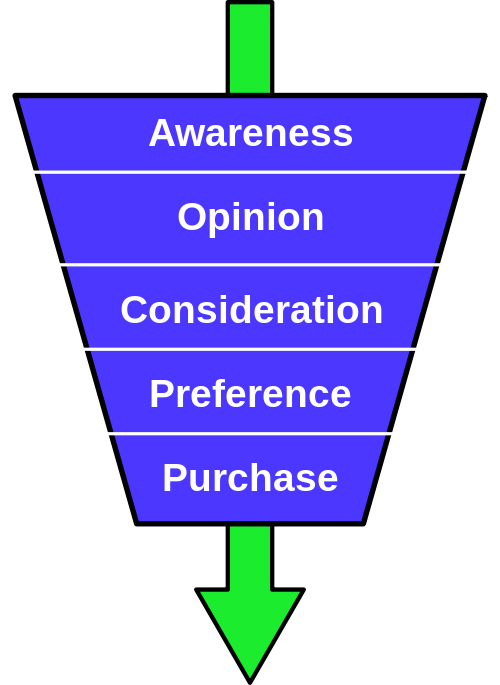
In the last Thursday’s Thought we covered adblocking as the first horseman of the Adblockalypse. We explored the myriad reasons behind the growth of adblocking. Today we uncover the second horseman of the Adblockalypse: Viewability.
What is Viewability?
A display ad is rated as viewable when 50% of the ad’s pixels are on the screen for a minimum of one second according to a joint study of the Media Ratings Council and the IAB (Interactive Advertising Bureau).
Before we explore how viewability is connected to adblocking, we might just have a quick scan over how we got to viewability becoming a new targeting method for brands and agencies.
What is your strength can also be your weakness
Digital advertising is great because everything can be measured, down to the last click, right? Well, not always. This often-boasted accountability is simultaneously a great strength and a major vulnerability.
One of the issues in digital advertising is that often the chosen success metrics in digital advertising are not always the best ones to focus on.
Not all clicks are created equal
CTR or Click Through Rate, for example should not be a sole measure the success of a display advertising campaign. CTR is calculated by dividing the number of ads served by the number of clicks on the ad multiplied by 100. CTR = Clicks/Impressions x 100 e.g. 25 clicks/200,000 ads x 100 = 0.0125%
So many factors come in to play to achieve a high CTR.
For example, it depends on:
- Dwell time (the time spent on the property: site, app).
- The quality of the creative and the call to action on the creative.
- Whether the creative is part of an integrated campaign across multiple touch points.
- The source of the traffic: often traffic referred from social platforms has a very short dwell time and high bounce rate (Bounce Rate is the percentage of single-page sessions/sessions where a person left the site from the entrance page without interacting with another page). This kind of traffic is large for publishers. Let’s think of the user in this context for a moment. They are on a social net, say Facebook. They click on a link shared or liked by their friend and they arrive on the article, they thumb down through the image and headline and scan the article for 8 seconds and bounce out of there back to the platform they are on and do it repeat this process through on a plethora of sites. So their dwell time is low and this leads to a lower ctr, whether or not they see the ad.
Display advertising performs well from a branding and engagement perspective, especially when it is placed beside quality content, it is in context and on a platform which provides a great user experience. This is a reason why CTR alone should not be the basis of campaign efficacy. This is also why advertising campaigns need to be treated holistically, with the campaign message similar on every platform, but adapted for each specific platform.
Display’s problem of attribution
Marketing attribution modelling is where an advertiser or agency figures out how a campaign performed from every source. This process enables us to understand the Return On Investment (ROI) of each marketing channel.
The problem display suffers from stems back to the point we made that it is not always great that Digital advertising is measurable down to the last click, because often there is none, well none on the display ad anyway.
Here is what often happens: you are a user and you are surfing the web sitting beside your partner who is on Facebook and you both have the TV on in the background to have some common denominator as you sit together connected but alone. You see an ad on the high quality site (content) you are surfing, this site has the ad in a prime position (viewable), the creative is clear (high quality creative) and it is promoting something you happen to be interested in (context). So, you click the ad, right? Well, not necessarily, you may see the ad, but type the campaign name into google or visit the advertised website directly, you might not always click the ad if at all, but it has done it’s just to raise awareness. In this case the search advertising may get an attribution score. So, display loses the attribution score on that one.
Another way to think of it, is to think that display advertising can sit at a few points along the marketing funnel. However, while it may do its just of raising product awareness, it may not be credited for this at all. It can sit at awareness stage, but also at consideration stage, especially if there is targeting, retargeting or personalisation in practice. Often you can see display will raise awareness, but the user may use search to get to the product and search will be attributed the sale of the product because this may have been the last click. We have seen through several studies the link between radio and TV advertising and search performing well in unison.

The rise of Viewability
Due to the low CTR of display advertising and the fact that there is a discrepancy between ads served and ads viewed, advertisers and agencies as well as governing bodies such as the IAB and MRC have decided to do something about this.
Viewable impressions are increasingly replacing a previously used metric served impressions. The latter measures how many times an advertisement was transmitted (or served), while viewable impressions measures how many times an ad – which was served – was capable of being seen by a user.
According to Google 50% of all impressions are not viewable and because of this many advertisers are demanding that they only pay for the viewable impressions.
The Interactive Advertising Bureau or IAB introduced a set of guidelines for publishers and advertisers alike. It is called the Transaction Principles and recommends that the goal should be 10o% viewability, but 70% should be the immediate goal.
While this all may sound perfectly logical, it means a new challenge for publishers in an already difficult to navigate ever changing ecosystem.
Jumping through (more) hoops

In Homer’s Odyssey there is a point in the story when Odysseus arrives home after many hurdles he had to overcome. Odysseus, presumed dead to many, disguises his identity because he wants to assess the loyalty of his wife while he was away. His wife, suspecting that he might be her long-lost husband organizes an archery contest and promises to marry any man who can string Odysseus’s great bow and fire an arrow through a row of twelve axes — a feat that only Odysseus has ever been able to accomplish. Of course, Odysseus steps up to the bow and, with little effort, fires an arrow through all twelve axes.
This task reminds me of how publishers constantly encounter new hurdles to overcome. The landscape keeps shifting, from changes in social media algorithms to changes in rankings for mobile optimisation like mobilegeddon to the growth of ad blockers and adblockalypse. Now viewability represents a new challenge as publishers need to redesign their web properties to make ads more viewable and to retain their already challenged digital revenue streams.
Why are served ads not viewable already?
Next week we will look in depth at ad fraud, which is a major contributing factor towards both Adblockalypse and low viewability. There are a variety of fraud techniques in train such as pixel stuffing, ad stacking and ghost sites, but there are other reasons too.
- Ads loading (being served) before the user gets to see them, perhaps they come to your page via social and scan the first few paragraphs and move on before they get to the ad at all
- Ad positioning is literally where the ad sits on the page
- Slow loading of content, when the content loads slower it means the user moves on quicker and in these instances the ad may be served, but due to frustration the user may have moved on.
Problems with Solutions
Now, let’s consider some solutions, but let’s also look at how these solutions can further feed the Adblockalypse.
The challenge publishers are faced with is they need to ensure that more of their served impressions are viewable. Let’s look at how this can be tackled.
Ads need to be more and more above the fold (the fold is based on the fold of the newspaper, where the top is considered more visible than the bottom, this term was inherited into digital publishing). To achieve this, publishers need to do some site and app design and optimisation to arrange ads to be more visible around content and places they will be viewable. While this optimisation works for a d viewability, it can lead to site and app clutter and a deterioration in user experience. This is a problem with this solution, increasing viewability often means paying a price in user experience and that can lead the user straight into the welcoming arms of an adblocker.
Further viewability tactics include slowing the loading of content for a split second to allow ads to be viewable for slightly longer. You will also see ads sticking to the right of pages as you scroll down in web, this leads to high viewability of that ad and higher dwell time and this directly correlated with a higher CTR.
So looking at solutions, they can cause problems. When a lot of advertising, especially for smaller publishers is bought programmatically and viewability affects the publisher’s rating you can see the incentive to make immediate changes is strong.
In summary: Viewability = more advertising revenue = survival (possibly), but…..required changes = increased viewable impressions = deterioration in user experience = rise of adblockers.
Some Solid Solutions
There are some common denominators that keep cropping up everytime we explore a topic in the digital publishing world.
Trust is essential, trust in the publishers content (does it deliver it’s promise?), trust in the site or app you are buying advertising from, (know the salesteam, meet them, whether you be an agency or direct client).
User experience is essential, resisting easy fixes for viewability and retaining the user experience and thus audience you fought so hard to recruit is essential. Remember it costs between 4 and 10 times more to acquire a new customer than it does to keep an existing one.
— — — — — — — — — — — — — — — — — — — — — — — — — — — — — —
Subscribe to the RTÉ Innovation Show for an upcoming exclusive interview about trust and relationships with Ted Rubin, leading Social Marketing Strategist, Keynote Speaker, Brand Evangelist and Acting CMO of Brand Innovators and author of the bestselling ‘Return on Relationship’.
We talk to Kingsley Aikens, CEO and founder of Diaspora Matters as he tells us about the importance of business networking and getting away from our desks.
We continue our “Masters of Imagination” series. Chief Imagination Officer with Katawave, Barry Winkless tells us why Heston Blumenthal is a master innovator.
As part of #RTÉSupportingTheStarts we talk to Andreea Wade, CEO and founder of Opening.io